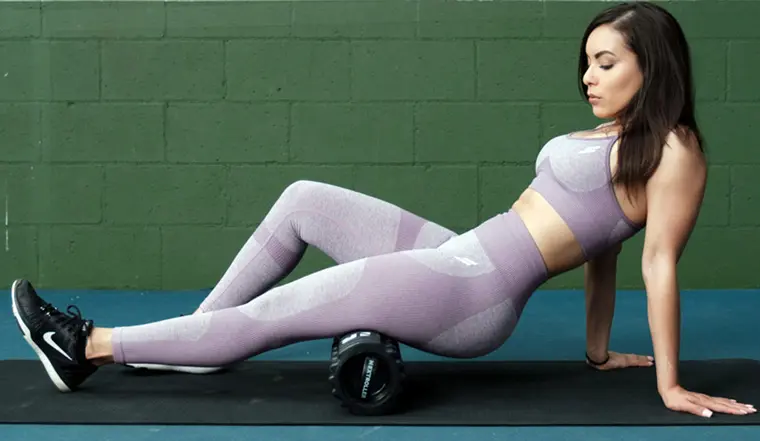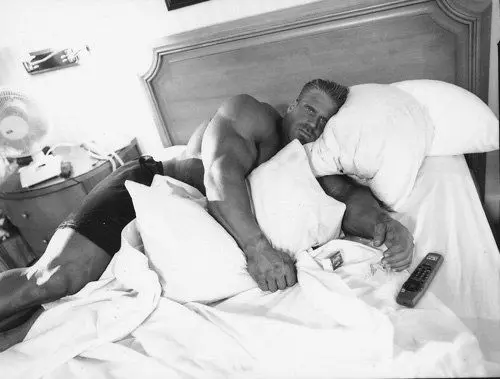Intense strength training takes a lot out of your body. It causes muscle microtrauma, depletes your intramuscular carbohydrate stores (glycogen), depletes your nervous system energy, and can leave you feeling exhausted. This all goes doubly true for leg day!
The reality is that, after a hard workout, you are actually weaker and smaller than you were before it. It takes time for your body to “bounce back” – and that’s what the recovery process is all about.
After sufficient rest, your muscles increase in strength and size, and your glycogen stores are replenished. All this means that the next time you train that same muscle group, you are better equipped for the demands of your workout.
Because of this, a lot of bodybuilders only train each muscle group once every seven days, using a weekly body part split. While this can be effective, such long breaks between workouts can also mean that your progress is not as fast as it could be.
So, what if you could recover faster and train more often? Instead of training a muscle group once every seven days, train it every five days instead, or even train it twice a week.
Your progress would be significantly faster, right?
Level Up Your Fitness: Join our 💪 strong community in Fitness Volt Newsletter. Get daily inspiration, expert-backed workouts, nutrition tips, the latest in strength sports, and the support you need to reach your goals. Subscribe for free!
If you are frustrated with your lack of progress and would like to try and train more frequently, you need to start paying more attention to recovery.
Use the following strategies to recover faster, train more often, and get better results from your workouts.
8 Ways to Speed Up Your Recovery After Training
These strategies are listed in the order that they should be used after your workout has finished. The first items are arguably the most important, and the last few are useful but less essential. Do as many as you can, but prioritize the first four as they provide the biggest bang for your buck.
1. Cool Down Properly
The last thing you’ll probably want to do after a hard workout is more training, but an active cool down is the best way to kickstart the recovery process. When you train, blood pools in the muscles you’ve been working, and, with it, the waste metabolites of exercise, including lactic acid and carbon dioxide.
Before recovery can start, these byproducts need to be flushed away with freshly oxygenated blood. This will happen naturally over time, but you can speed up the process by cooling down properly.
Simply hop on an exercise bike, treadmill, or rower, and do 5-10 minutes of light cardio. There is no need to go over about 60% of your maximum heart rate. If you are out of breath, you are going to fast.
This mini-cardio workout will infuse and flush your muscles with oxygenated blood, clearing out those recovery-delaying substances. As an added benefit, you may also experience less delayed onset muscle soreness (DOMS) if you cool down properly (1).
2. Post-workout Nutrition
Glycogen is carbohydrate stored in your muscles and liver. An intense workout can deplete this valuable source of energy, and you won’t be able to train that muscle group again until those stores are replenished.
Immediately after training, and for the next few hours, your muscles are very sensitive to the effects of insulin. This means that almost everything you eat in the post-workout period will be preferentially shunted into your muscles and liver. Consuming food now means that your glycogen stores will be replenished sooner.

In addition, increased insulin sensitivity also means that amino acids are driven more efficiently into your muscle cells. Hard strength training damages your muscles at a microscopic level. While that might sound like bad news, it’s this damage that is responsible for muscle growth. Your body needs amino acids to repair and build muscle tissue.
Consuming fast-acting carbs and protein immediately after your workout ensures your body gets a hefty dose of the nutrients it needs to get the recovery process started sooner.
Ideally, you should chug down a protein and carb recovery shake straight after your cool down (2). Keep the recovery process rolling by eating a high protein and carb meal within two hours of training too.
3. Contrast Showers
Top sportspeople use contrast showers and baths to speed up recovery after training, and you can do it too. Contrast showers involve alternating between very cold and very hot water. The cold water causes vasoconstriction, where the blood vessels contract and narrow. The hot water causes vasodilation, where the blood vessels open up again (3).

Alternating between hot and cold showers creates a pumping effect that increases blood flow. If possible, focus the water jet on the muscles you have just been training. Always finish with hot water, so your blood vessels are dilated when you exit the shower.
4. Move More, and Sit Less
Sitting around doing nothing might seem like a good way to speed up recovery, but being sedentary is more likely to lead to post-exercise muscle soreness and stiffness. You’ll recover faster if you sit less and move more.

Anything that gets you up and moving will enhance recovery, with the proviso that you don’t overdo it. The aim is to move your body, not tire yourself out.
Good options include:
- Going for a walk
- Stretching
- Swimming
- Gardening or DIY chores
If nothing else, breaking up long periods of sitting with short walks will help prevent muscle soreness and stiffness while increasing blood flow and speeding up recovery.
5. Recovery Workouts
One of the best ways to speed up recovery is also the most counter-intuitive – training the same muscle group again the very next day.
Level Up Your Fitness: Join our 💪 strong community in Fitness Volt Newsletter. Get daily inspiration, expert-backed workouts, nutrition tips, the latest in strength sports, and the support you need to reach your goals. Subscribe for free!
While this may sound crazy, before you dismiss this strategy, it’s important to understand what a recovery workout entails.

In simple terms, it’s a very VERY easy workout in which you move your muscles without overloading them. For example, if you did heavy squats yesterday, you’ll do a few sets of body weight or empty bar squats today. Simply repeat some of the exercises from your previous workout using very light loads.
This will pump freshly oxygenated and nutrient-rich blood into your recently trained muscles, providing them with what they need to recover faster.
One way to do this is to combine your recovery workout with your warm-up for your next workout. Alternatively, you can do a few bodyweight and resistance band exercises at home instead.
Either way, training the same muscle group 24 hours later is a great way to speed up recovery and reduce post-exercise muscle soreness.
6. Foam Roll
Your body is made up of over 600 muscles, and each one is surrounded and linked by a connective tissue called fascia. Think of fascia like a net that covers and separates all your muscles.
Fascia can get “gummed up” and adhere to the underlying muscle tissue. This can reduce blood flow, inhibiting recovery, and also reducing your range of motion and even causing muscle pain. You can free your fascia by using a foam roller (4).

Foam rolling, which is a form of self-myofascial release, massages the fascia and the underlying muscle tissue to eliminate adhesions. While initially painful, foam rolling quickly becomes quite enjoyable, and can even be relaxing.
Focus on the muscles you have just worked, and any other muscle groups that feel sore or tight.
7. Compression Clothing
A lot of lifters like to wear compression clothing during training. It helps keep your muscles warm, may reduce fatigue, provides a little bit of support, and may even increase workout performance by increasing kinesthetic awareness. In other words, it increases the mind/muscle connection.
But studies also suggest that wearing compression clothing AFTER training can enhance recovery. Compression clothing speeds up recovery by reducing post-training inflammation, swelling, and fluid accumulation. It also increases tissue temperature and improves blood flow (5).
Wearing compression clothing for 12-24 hours after a workout should enhance recovery, and you can also wear it to make things like foam rolling and recovery workouts even more effective.
8. Get More Sleep
Sleep deprivation can have a very negative effect on recovery. Not getting the recommended 7-9 hours of sleep will interfere with the production of the anabolic hormones testosterone and human growth hormone, both of which are crucial for recovery and muscle growth (6).
While getting enough shut-eye should be easy, a lot of lifters have forgotten how to get a good night’s sleep. Instead of going to bed, they spend time being distracted by TV, tablets, and smartphones.

The only reliable way to get enough sleep each and every night is to go to bed earlier. Work back eight hours from the time you have to get up – that’s the time you should be going to bed.
Switch off your phone, leave your laptop in another room, and don’t have a TV in your bedroom. That way, you won’t be tempted to do anything other than sleep. Also, make sure your bedroom is a nice place to be. It should be airy, clean, uncluttered, and comfortable. Do whatever you need to do to make your environment as conducive to sleep as possible.
Sleep might not be the most exciting way to pass the night away, but it’s arguably the most important if you want to recover from your workouts as fast as possible. After all, this is the most anabolic part of your day!
Wrapping up
If you train hard, you need to recover hard too. While you can recover passively, just by resting, you’ll recover faster if you participate actively in the process. Feed your muscles, take steps to increase blood flow, reduce inflammation, and get plenty of sleep. Focusing on recovery means you can get back in the gym sooner, and more workouts mean faster progress.
References:
1 – PubMed: Do We Need a Cool-Down After Exercise? A Narrative Review of the Psychophysiological Effects and the Effects on Performance, Injuries, and the Long-Term Adaptive Response. https://www.ncbi.nlm.nih.gov/pmc/articles/PMC5999142/
2 – PubMed: Nutrient timing revisited: is there a post-exercise anabolic window? https://www.ncbi.nlm.nih.gov/pmc/articles/PMC3577439/
3 – PubMed: Contrast water therapy and exercise-induced muscle damage: a systematic review and meta-analysis. https://www.ncbi.nlm.nih.gov/pmc/articles/PMC3633882/
4 – PubMed: Foam rolling for delayed-onset muscle soreness and recovery of dynamic performance measures. https://pubmed.ncbi.nlm.nih.gov/25415413/
5 – PubMed: Effects of compression tights on recovery parameters after exercise-induced muscle damage: A randomized controlled crossover study. https://www.ncbi.nlm.nih.gov/pmc/articles/PMC6341249/
6 – PubMed: Effects of sleep deprivation on acute skeletal muscle recovery after exercise. https://pubmed.ncbi.nlm.nih.gov/31469710/









